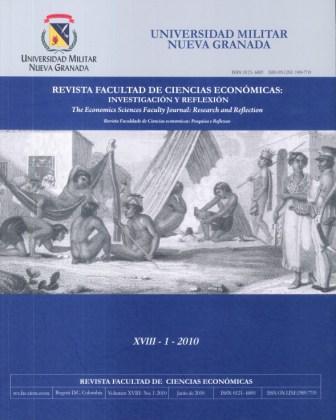Cambio estratégico para entornos turbulentos
Resumen
En los últimos años, las empresas se han visto enfrentadas a un entorno turbulento, caracterizado principalmente por presentar incertidumbre, dinamismo y complejidad. La incertidumbre se hace evidente al momento de tomar decisiones; sin lograr tener certeza sobre lo que puede pasarle a la empresa; el dinamismo se logra observar por el cambio permanente en las necesidades de los clientes y surgimiento de nuevos productos, que origina incremento de la rivalidad por precio; y la complejidad puede identificarse en el surgimiento de nuevos actores con los que se debe interactuar para llevar a cabo una transacción. La academia de la administración ha buscado mecanismos para enfrentarse a la turbulencia. En el presente documento se presenta una revisión teórica del concepto de turbulencia, haciendo énfasis en la forma como debe enfrentarse el fenómeno mediante el cambio estratégicoDescargas
Lenguajes:
esAgencias de apoyo:
Universidad del RosarioReferencias bibliográficas
Akgun, A., Byrne, J., Lynn, G., & Keskin, H. (2007). New Product development in turbulent environments: Impact of improvisation and unlearning on new product performance. Journal of Engineering and technology Management, 24, 203-230. http://dx.doi.org/10.1016/j.jengtecman.2007.05.008
Aldrich, H. (1979). Organizations and environments. Pretice -Hall.
Anderson, C., Paine, F. (1975). Managerial Perceptions and Strategic Behavior The Academy of Management Journal, 18 (4), 811-823.
Andrews, K. (1980). The Concept of Corporate Strategy. Homewood, III. R.D. Irwin.
Ansoff, I. (1965). Corporate strategy: An analytic approach to business policy for growth and expansion. New York: McGraw- Hill.
Ansoff, Igor [1993]. El planeamiento Estratégico. Nueva tendencia de la Administración./ H Ansoff, R. P. Declerk y Hayes R. I./ Editorial Trillas, México
Ansoff, I. (1990). General management in turbulent environments. The Practising Manager, 11 (1), 2.
Ansoff, I., Eppink, J., & Gomer, H. (1979). Management of Strategic surprise and discontinuity: problem of managerial decisiveness. Economies et Sociétés, série Sciences de Gestión (1), 459-488.
Anssoff, H., & Sullivan, P. (1993). Empirical support for a paradigmatic theory of strategic sucess behavior of enviroment serving organization. International Review of Strategic, 4, pp. 173-203.
Argyris, C. (1985). Strategy, Change and Defensive Routines. Boston, MA: Pitman.
Ayadurai, S. & Sohail, S. (s.f.). The Effect on Environmental Turbulence on Entrepreneurial Behaviour and Performance of Multinational Subsidiaries inMalasya. Recuperado el 27 de Agosto de 2008, de Ubinary University College: http://www.binary.edu.my/research/enviroment.pdf
Barnett, W. & Carroll, G. (1995). Modeling Internal Organizational Change. Annual Review of Sociology, 21, 217-236. http://dx.doi.org/10.1146/annurev.so.21.080195.001245
Becherer, R. & Maurer, J. (1998). The moderating effect of environmental variables on the entrepreneurial and marketing orientation of entrepreneurled firms, Entrepreneurship Theory and Practice, 22(1): 47-58.
Bennis, W. (1966). Changing organizations: Essays on the development and evolution of human organization. New York: McGraw Hill. http://dx.doi.org/10.1177/002188636600200301
Beesley, M. & Hamilton, R. (1984). Small Firms' Seedbed Role and the Concept of Turbulence. The Journal of Industrial Economics, 33(2): 217-231. http://dx.doi.org/10.2307/2098510
Bettis, R. & Hitt, M. (1995). The new competitive landscape. Strategic management Journal, 16, 7-19. http://dx.doi.org/10.1002/smj.4250160915
Bhattacharya, A., Jina J. & Walton, A. (1996). Product-market, turbulence and time compression: three dimensions of an integrated approach to manufacturing systems design, International Journal of Operations & Production Management, Vol. 16 No.9, pp.34-47. http://dx.doi.org/10.1108/01443579610125570
Bian, D. (2006). Strategy formualtion and implementation in turbulent business enviroments: refefining organizations and their leadership formation. 202. Barcelona: IESE Business School, Espa-a.
Bitar, J. (2003). Strategy in Turbulent Environment Continuous Innovation and Generic Dynamic Capabilities. Montreal: HEC.
Blumenthal, B; Haspeslagh,P. (1994). Toward a Definition of Corporate Transformation, Sloan Management Review 35(3): 101-107
Boeker, W. (1989). Strategic change: the effects of founding and history. Academy of Management Journal, 32, 489-515. http://dx.doi.org/10.2307/256432
Bourgeois, L. (1985). Strategic goals, perceived uncertainty, and economic performance in volatile environment. Academy of Management Journal, 28 (3), 548-573. http://dx.doi.org/10.2307/256113
Bourgeois, L. & Eisenhardt, K. (1988). Strategic Decision Processes in High Velocity Environments: Four Cases in the Microcomputer Industry. Management Science, 34 (7), 816-835. http://dx.doi.org/10.1287/mnsc.34.7.816
Boyd, B. (1990). Corporate linkages and organizational environments: a test of resource dependence model. Strategic Management Journal, 11 , 419-430. http://dx.doi.org/10.1002/smj.4250110602
Boyd, B.; Dess, G;. Rasheed, A. (1990) Divergence between Archival and Perceptual Measures of the Environment: Causes and Consequences. The Academy of Management Review, 18, (2), 204-226.
Boyne, G. & Meier, K. (2009). Environmental Turbulence, Organizational Stability, and Public Service Performance. Administration & Society, 40 ((8)), 799-824. http://dx.doi.org/10.1177/0095399708326333
Brandon, K. (2004). Change and persistence in a Christian liberal arts institution: A case study. Doctoral thesis Unpublished. Ypsilanti: Eastern Michigan University.
Brown, S. & Eisenhardt, K. (1997). The Art of continuous change: linking Complexity theory and Time-Paced Evolution in Recentlessly Shifting Organizations. Administrative Science Quarterly, 42 ((1)), 1-34. http://dx.doi.org/10.2307/2393807
Brown, S. & Eisenhardt, K. (1998). Competing on the edge: strategy as structured chaos. Boston: Harvard Business School Press.
Brown, T. & Kirchhoff, B. (1997). The effects of resource availability and entrepreneurial orientation on firm growth, Frontiers of Entrepreneurship Research 1997. Edition. www.babson.edu/entrep/fer/papers97/kirtchoff/kir1.htm.
Buganza, T., Dell'Era, C., & Verganti, R. (2009). Exploring the Relationship Between Product Development and Environmental Turbulence: The Case of Mobile TLC Services. Product Innovation Managament, 26, 308-321. http://dx.doi.org/10.1111/j.1540-5885.2009.00660.x
Burns, T. & Stalker, G. (1961). The Management of Innovation. London: Tavistock.
Calantone, R., Garcia, R. & Droge, C. (2003). The Effects of Environmental Turbulence on New product Development Strategy Planning. Journal of product Innovation Management, 20, 90-103. http://dx.doi.org/10.1111/1540-5885.2002003
Calantone, R., Schmidt, J. & Di Benedetto, A. (1997). New product Activities and Performance: The Moderating Role of Environmental Hostility. Journal of Product Innovation Management, 14, 179-189. http://dx.doi.org/10.1111/1540-5885.1430179
Caldart, A. & Ricart, J. (2006). Corporate Strategy in turbulent Environments: Key Roles of the Corporate Level. Working Paper (623), 31. Barcelona, Spain: IESE Business School -University of Navarra.
Callot, P. (1997), Déterminants Structurels et Stratégiques, Perception de l'Environnement et Influence sur le Champ Concurrentiel de la Restauration Commerciale en France. Thèse, IAE de Poitiers, 6 janvier 1997, 482 p.
Cameron, K. (1984). Organizational Adaptation and Higher Education. The Journal of Higher Education, 55 (2), 122-144. http://dx.doi.org/10.2307/1981182
Cameron, K., Kim, M. & Whetten, D. (1987). Organizational Effects of Decline and Turbulence. Administrative Science Quarterly, 32, 222-240. http://dx.doi.org/10.2307/2393127
Camillus, J. & Datta, D. (1991). Managing strategic issues in a turbulent environment. Long Range Planning, 24 (2), 67-74. http://dx.doi.org/10.1016/0024-6301(91)90081-X
Castrogiovanni, G. J. (1991). Environmental munificence: A theoretical assessment. Academy of Management Review, 16 (3), 542-565.
Chaffee, F. (1985). Three Models of Strategy. Academy of Management Review, 10 (1), 89-98.
Chakravarthy, B. (1997). A New Strategy Framework for Coping with Turbulence. Sloan Management Review, 69-82.
Child, J. (1975). Managerial and Organizational Factors Associated with Company Performance, part II- A Contingency Analysis. Journal of Management Studies, 12 (1-2), 12-27. http://dx.doi.org/10.1111/j.1467-6486.1975.tb00884.x
Child, J. (1972). Organizational Structure, Environment and Performance: The Role of Strategic Choice. Sociology, 6 (1), 122. http://dx.doi.org/10.1177/003803857200600101
Coutney, H. (2001). 20/20 foresight: crafting strategy in an uncertain world Boston, Mass. Harvard Business School Press.
Covin, J. & Slevin, D. (1989). Strategic Management of Small Firms in Hostile and Benign Environments. Strategic Management Journal, 10 (1), 75-87. http://dx.doi.org/10.1002/smj.4250100107
Craig, T. (1996). The Japanese beer Wars: Initiating and Responding to Hypercompetition in New Product Development. Organization Science, 7 (3), 302-321. http://dx.doi.org/10.1287/orsc.7.3.302
Crossan, M., Vera, D.m & Nanjad, L. (2008). Transcendent leadership: Strategic leadership in dynamic environments. The leadership quarterly, 19 ((5)), 569-581. http://dx.doi.org/10.1016/j.leaqua.2008.07.008
D'Aveni, R. (2004). The rise of Hypercompetitiion from 1950 to 2002: Evidence of increasing structural destabilization and temporary competitive advantage.
D'Aveni, R. (1994). Hypercompetition. Managing the Dynamics of Strategic Manauvering. New York: Free Press.
Daft, R., Sormusen,J. & Parks, D. (1988). Chief executive scanning, environmental characteristics and company performance: an empirical study. Strategic Management Journal, 9, 123-139. http://dx.doi.org/10.1002/smj.4250090204
Dante, R. (2002). Estrategia de Ventas en Tiempos de Turbulencia. Recuperado el 10 de Agosto de 2008, de http://fce.uncu.edu.ar/investigacion/Jornadas/jornadas2002/Dis/Administracion/54/T54.pdf
Davis, D., Morris, M. & Allen, J. (1991). Perceived environmental turbulence and its effects on selected entrepreneurship, marketing and organizational characteristics in industrial firms. Journal of the Academy of Marketing Science, 19 (1), 43-51. http://dx.doi.org/10.1007/BF02723423
Dess & Beard, D. (1984). Dimensions of organizational task environments. Administrative Science Quarterly, 52-73. http://dx.doi.org/10.2307/2393080
Dess, G., Lumpkin, G. & Covin, J. (1997). Entrepreneurial strategy making and firm performance: tests of contingency and configurational models. Strategic Management Journal, vol. 18(9): 677-695. http://dx.doi.org/10.1002/(SICI)1097-0266(199710)18:9<677::AID-SMJ905>3.0.CO;2-Q
Dessler, G. (1992). Organization theory: Integrating structure and behaviour (Second edition ed.). London,UK: Prentice-Hall International Limited.
Downey, H. H. (1975). Environmental uncertainty: the construct and its application. Administrative Science Quarterly, 20, 613629. http://dx.doi.org/10.2307/2392027
Downey, H., Slocum, J. (1975). Uncertainty: Measures, Research, and Sources of Variation . The Academy of Management Journal, Vol. 18, (3): 562-578 http://dx.doi.org/10.2307/255685
Droge, C., Calantone, R. & Harmancioglu, N. (2008). New Product Success: Is It Really Controllable by Managers in Highly Turbulent Environments? The Journal of Product Innovation Management (25), 272-286. http://dx.doi.org/10.1111/j.1540-5885.2008.00300.x
Drucker, P. (1980). Managing in Turbulent Times. New York: Harper & Row.
Dufour, Y. & Steane, P. (2006). Competitive paradigms on strategic change: mapping the field and further research development. Strategic Change, 15 (3), 129-144. http://dx.doi.org/10.1002/jsc.758
Duncan, R. (1972). Characteristics of Organizational Environments and perceived Environmental Uncertainty. Administrative Science Quarterly, 17 (3). http://dx.doi.org/10.2307/2392145
Duncan, R. (1974). Multiple Decision-making Structures in Adapting to Environmental Uncertainty: The Impact on Organizational Effectiveness. Human Relations, 26 (3), 273-291. http://dx.doi.org/10.1177/001872677302600301
Dunphy, D. (1996). Organizational Change in Corporate Settings. Human Relations 49: 541-552. http://dx.doi.org/10.1177/001872679604900501
Dutton, J. & Duncan,R. (1987). Strategic Issue Diagnosis and Creation of Momentum for Change. Strategic Management Journal, 8 (3), 279-295. http://dx.doi.org/10.1002/smj.4250080306
Dwyer, R. & Welsh, A. (1985). Environmental Relationship of the Internal Political Economy of Marketing Channels. Journal of Marketing Research, XII, 397-414. http://dx.doi.org/10.2307/3151585
El Sawy, O. & Pavlou, P. (2008). IT-Enabled Business capabilities for Turbulent Environments. MIS Quarterly Executive, 7 (3), 139-150.
Emery, F. & Trist, E. (1965). The Causal Texture of Organizational Environments. Human Relations, 18 (21), 21-32. http://dx.doi.org/10.1177/001872676501800103
Fiss, P., & Zajac, E. (2006). The symbolic management of strategic change: sense - giving via framing and decoupling. Academy Management , 49, 1173-1193. http://dx.doi.org/10.5465/AMJ.2006.23478255
Forbes, D., Manrakhan, S. & Banerjee, S. (2004). Strategic responses to an environmental jolt: Executive turnover in Internet IPOs. The Journal of Private Equity, 8, 63-93. http://dx.doi.org/10.3905/jpe.2004.450953
Freeman, C. & Soete, L. (1997). The economics of industrial Organization. MIT. 1997. Cambridge. US.: MIT.
Galbraith, J. (1973). Designing Complex Organizations. Reading, MA: Addison-Wesley Publishing Co.
Ganesan, S. (1994). Determinants of Long-Term Orientation in Buyer-Seller Relationships. The Journal of Marketing, 58 (2), 1-19. http://dx.doi.org/10.2307/1252265
García, S., Dolan, S. & Navarro, C. (1999). La dirección por valores para animar la empresa en entornos turbulentos. Harvard Deusto business review, 78-89.
Ginsberg, A. (1998). Measuring and modelling changes in strategy: Theoretical foundations and empirical directions. Strategic Management Journal, 9: 559-575. http://dx.doi.org/10.1002/smj.4250090604
Gioia, D. A. & Chittipeddi, K. (1994). Sense making and sense giving in strategic change initiation. Strategic Management Journal, 12, 433-448. http://dx.doi.org/10.1002/smj.4250120604
Gioia, D., Thomas, J. J., Clark, S., & Chittipeddi, K. (1994). Symbolism and strategic change in academia: The dynamics of sense making and influence. Organizational Science , 5, 363-383. http://dx.doi.org/10.1287/orsc.5.3.363
Glazer, R. & Weiss, A. (1993). Marketing in Turbulent Environments: Decision Processes and the Time-Sensitivity of Information. Journal of Marketing Research, 30 (November), p. 509-521. http://dx.doi.org/10.2307/3172694
Gordon, S.S., Stewart, W.H., Sweo, R., & Luker, W.A. (2000). Convergence versus strategic reorientation: The antecedents of fast-paced organizational change, Journal of Management, 26, 911-945. http://dx.doi.org/10.1177/014920630002600508
Gray, B. & Ariss, S. (1985). Politics and strategic change across organizational life cycles. Academy of Management Review, 10 (4), 707-723.
Grant, R. (2003). Strategic Planning in a Turbulent Environment: Evidence from Oil Majors. Strategic Management Journal, 24, 491-517. http://dx.doi.org/10.1002/smj.314
Greenspan, A. (2007). The Age of Turbulence: Adventures in a New World. Nueva York: Penguin.
Gueguen, G. (2001). Http://Www.Sciencesdegestion.Com/These/These.Zip.
Gueguen, G. (1997). Face aux turbulences, l'entreprise doitelle être réactive? Propos de réflexion. Vlème conférence de 'AIMS. Montreal: HEC.
Hall, R. (1996). Organizaciones, Estructuras, Procesos, y Resultados. México: Prentice Hall.
Hall, J. & Rosson, P. (2006). The Impact of technological Turbulence on Entrepreneurial behavior, Social Norms and Ethics: Three Internet-based Cases. Journal of Business Ethics , 64, 231-248. http://dx.doi.org/10.1007/s10551-005-5354-z
Hambrick, D. (1983). High Profit Strategies in Mature Capital Goods Industries: A Contingency Approach. The Academy of Management Journal , 26 (4), 687-707. http://dx.doi.org/10.2307/255916
Head, T. (2005). Structural Changes in turbulent Environments: A Study of Small and Mid-Size Chinese Organizations. Journal of Leadership & Organizational Studies, 12 (2), 82-93. http://dx.doi.org/10.1177/107179190501200207
Hofer, C. & Schendel, D. (1978). Strategy formulation: Analytical concepts. St. Paul: West Pub. Co. (St. Paul).
Huber, G. (1984). The nature and design of post-industrial environments, Management Science, 30: 928-951. http://dx.doi.org/10.1287/mnsc.30.8.928
Ireland, R., Hitt, M., Bettis, R. & Porras, D. (1987). Strategy formulation processes: differences in perceptions of strength and weakness indicators and environmental uncertainty by managerial level, Strategic Management Journal, 8: 469-485. http://dx.doi.org/10.1002/smj.4250080506
Janis, I. (1962). Psychological effects of warnings. In G. W. Baker and D. W. Chapman (eds,), Man and Society in Disaster: 5692, New York: Basic Books,
Jaworski, B. & Kohli, A. (1993). Market Orientation: Antecedents and Consequences. Journal of Marketing, 57 (3), 53-70. http://dx.doi.org/10.2307/1251854
Jennings, D., & Seaman, S. (1994). High and low levels of organizational adaptation: an empirical analysis of strategy, structure and performance. Strategic Management Journal, 15, 459-475. http://dx.doi.org/10.1002/smj.4250150604
Joffre, P. & Koenig, G. (1984). Stratégies de coopération et d'alliance interentreprises. Enseignement et Gestion, n° 31, oto-o.
Johnson, G. & Scholes, K. (1999). Exploring Corporate Strategy: Text and Cases. Harlow, England: Prentice Hall.
Jurkovich, R. (1974). Core Typology of Organizational Environments. Administrative Science Quarterly, 19 (3). http://dx.doi.org/10.2307/2391979
Kalika, M. (1985). L'efficacité des entreprises estelle liée à leur structure ? Revue Française de Gestion , 93-104.
Khandawalla, P. (1972). Environment and its impact on the organization. International Studies of Management and Organization, 2, 297-313. http://dx.doi.org/10.1080/00208825.1972.11656125
Khandwalla, P. (1974). Mass Output Orientation of Operations Technology and Organizational Structure. Administrative Science Quarterly, 19 (1), 74-97. http://dx.doi.org/10.2307/2391789
Khandwalla, P. (1976-1977). Some top Management styles, their context and performance. Organizations and Administrative Sciences, 7 (4), 21-51.
Kotler, P., & Caslione, J. (2010). Caótica. Bogotá: Grupo Editorial Norma.
Kraatz, M. & Zajac, E. (2001). How Organizational Resources Affect Strategic Change and Performance in Turbulent Environments: Theory and Evidence. Organization Science , 12 (5), 632-657. http://dx.doi.org/10.1287/orsc.12.5.632.10088
Kuivalainen, O., Sundqvist, S., Puumalainen, K. & Cadogan, J. (2004). The Effect of Environmental Turbulence and Leader Characteristics on International Performance: Are Knowledge-Based Firms Different? Canadian Journal of Administrative Sciences, 21 (1), 35-50. http://dx.doi.org/10.1111/j.1936-4490.2004.tb00321.x
Langley, A. & Denis, J. (2006). Neglected Dimensions of Organizational Change: Towards. En R. Lines, I. Stensaker & A. Langley, & A. Langley, New Perspectives on Organizational Change and Learning (págs. 136-159).
Lawless, M. & Finch,K. (1989). Choice and Determinism: a Test of Hrebiniak and Joyce's Framework on Strategy - Environment Fit, Strategic Management Journ a l, 10, 351-365. http://dx.doi.org/10.1002/smj.4250100405
Lawrence, P. R. & Lorch, J. W. (1967). Organization and Environment. Homewood: Irwin.
Leker, J. (2001). Reorientation in a Competitive Environment: An Analysis of Strategic Change. Schmalenbach Business Review, 53, 41-55.
Lewin, K. (1951). Field theory in social science; selected theoretical papers. New York: Harper & Row.
Lewin, A. Y., & Volberda, H. W. (1999). Prolegomena on coevolution: A framework for research on strategy and new organizational forms. Organization Science, 10: 519-534. http://dx.doi.org/10.1287/orsc.10.5.519
Li, H. & Atuahene-Gima, K. (2001). The Impact of Interaction between R&D and Marketing on New Product Performance: An Empirical Analysis of Chinese High Technology Firms. International Journal of Technology Management , 21 ((1/2)), 61-75. http://dx.doi.org/10.1504/IJTM.2001.002902
Lichtenthaler, U. (2009). Absotive Capacity, Environmental Turbulence, and The Complementarity of Organizational Learning Processes. Academy of Management Journal, 52 (4), 822-846. http://dx.doi.org/10.5465/AMJ.2009.43670902
Lin, X. & Germain, R. (2003). Organizational Structure, Context, Customer Orientation, and Performance: Lessons from Chinese State-Owned Enterprises. Strategic Management Journal, Vol. 24, No. 11: 1131-1151. http://dx.doi.org/10.1002/smj.348
Lindsay, W. & Rue, L. W. (1980). Impact of the business environment on long range planning process: A contingency view. Academy of Management Journal, 23: 385-404. http://dx.doi.org/10.2307/255507
Lorsch, J.W. (1986). "Managing Culture: The Invisible Barrier to Strategic Change". California Management Review, 28: 95-109. http://dx.doi.org/10.2307/41165187
Makridakis, S. (1979). Accuracy of Forecasting: An Empirical Investigation. Journal of the Royal Statistical Society. Series A (General), 142, 2. 97-145. http://dx.doi.org/10.2307/2345077
Markoczy, L. (2000). La innovación estratégica en empresas ya establecidas. Harvard Deusto Business Review (81), 22-32.
Mason, R. (2006). Coping with compelxity and turbulence- An entrepreneurial solution. Journal of Enterpresing Culture , 14 (4), 241-266. http://dx.doi.org/10.1142/S0218495806000155
McCann, J. & Selsky, J. (1984). Hyperturbulence and the Emergence of Type 5 Environments. Academy of Management Review, 9 (3), 460-470.
Metcalfe, J. (1974). Systems Models, economics Models and the Causal Texture of Organizational Environments: An Approach to Macro-Organization Theory. Human Relations , 27 (7), 639-663. http://dx.doi.org/10.1177/001872677402700702
Metcalfe, L., & McQuillan, W. (1977). Managing Turbulence. TIMS/Studies in the Management Science, 5, 7-23.
Menninger, W. C. (1952). Psychological reactions in an emergency flood, American Journal of Psychiatry, 109: 128-130. http://dx.doi.org/10.1176/ajp.109.2.128
Meyer, A. (1982). Adapting to Environmental Jolts. Administrative Science Quarterly, 27, 515-537. http://dx.doi.org/10.2307/2392528
Miles, R. & Snow, C. (1978). Organizational Strategy, Structure and Process. McGraw-Hill.
Miller, D. (1982). Evolution and revolution: a quantum view of structural change in organizations. The Journal of Management Studies , 19 (2), 131-152. http://dx.doi.org/10.1111/j.1467-6486.1982.tb00064.x
Miller, D. (1988). Relating Porter's business strategies to environment and structure: analysis and performance implications. Academy of Management Journal, 31 (2), 280-308. http://dx.doi.org/10.2307/256549
Miller, D. (1983). The correlates of entrepreneurship in three types of firms. Management Science, 29 (7), 770-791. http://dx.doi.org/10.1287/mnsc.29.7.770
Miller, D. & Droge, C. (1986). Psychological and traditional determinants of structure. Administrative Science Quarterly, 31, 539-560. http://dx.doi.org/10.2307/2392963
Miller, D. & Friesen, P. (1982). Innovation in conservative and entrepreneurial firms: two models of strategic momentum. Strategic Management Journal, 3, 1-25. http://dx.doi.org/10.1002/smj.4250030102
Milliken, F. (1990). Perceiving and interpreting environmental change: an examination of college administrators interpretation of changing demographics". Academy of Management Journal , 33 (1), 42-63. http://dx.doi.org/10.2307/256351
Milliken, F. (1987). Three Types of perceived Uncertainty About the Environment: State, Efefct, and Response Uncertainty. Academy of Management Review, 12 (1), 133-143.
Mintzberg, H. (1990). The design school: Reconsidering the basic prernises of strategic management, Strategic Management Journal, 11, 171-195. http://dx.doi.org/10.1002/smj.4250110302
Mintzberg, H., Ahlstrand, B. & Lampel, J. (1988). Strategy Safari: A Guided Tour Through the Wilds of Strategic Management. New York: The Free Press.
Mintzberg, H. (1994). Rethinking Strategic Planning Part I. Pitfalls and Fallacies. Long range planning. 27 (3);12-21. http://dx.doi.org/10.1016/0024-6301(94)90185-6
Morris, M., Hansen & Pitt (1995). Environmental turbulence and organizational buying: the case of health benefits in south Africa. Industrial Marketing Management (24), 305-315. http://dx.doi.org/10.1016/0019-8501(95)00014-2
Mullins, J. Y Cummings, L. (1999). Situational strength. A framework for understanding the role of individuals in initiating proactive strategic change. Journal of Organizational Change Management, 12: 462-479. http://dx.doi.org/10.1108/09534819910300846
Nadler, D. & Tushman, M. (1989). Organizational frame bending: principles for managing reorientation. Academy of Management Executive, 3 (3), 194-204. http://dx.doi.org/10.5465/AME.1989.4274738
Nag, R., Hambrick, D. & Chen, M. (2007). What is Strategic Management Really Inductive Derivation of a Consensus Definition of The Field. Strategic Management Journal, 935-955. http://dx.doi.org/10.1002/smj.615
Naman, J. & Slevin, D. (1993). Entrepreneurship and the concept of fit: a model and empirical tests. Strategic Management Journal, 14, 137-153. http://dx.doi.org/10.1002/smj.4250140205
Narasimha, S. (2001). Strategy in turbulent Environments: The Role of Dynamic Competence. Managerial and decision Economics (22), 201-212.
Pascale, R. (1999). Surfing the edge of chaos. Sloan management review, 40 (3), 83-95.
Pettus, M., Kor, Y., & Mahoney, J. (2007). A Theory of Change in Turbulent Environments: The Sequencing of Dynamics Capabilities Following Industry Deregulation. The International Journal of Strategic Change Management, 1 (3), 186-211. http://dx.doi.org/10.1504/IJSCM.2009.024509
Pfeffer, J. & Salancik, G. (1978). The external control of organizations. New York.: Harper & Row.
Pine II, J. (1993). Mass customization: the new frontier in business competition. Boston: Harvard Business School Press.
Polley, D. (1997). Turbulence in Organizations: New Metaphors for Organizational research. Organization Science, 8 (5), 445-457. http://dx.doi.org/10.1287/orsc.8.5.445
Porter, M. (1991). Towards a dinamic theory of strategy. Strategic Management Journal , 12, 95-117. http://dx.doi.org/10.1002/smj.4250121008
Post, J. & Mahon, J. (1980). Articulated turbulence: The effect of regulatory agencies on corporate responses to social change. Academy of Management Review, 5 (3), 399. http://dx.doi.org/10.2307/257115
Power, B. & Reid, G. (2005). Flexibility, Firm-Specific Turbulence and the Performance of the Long-lived Small Firm. Review of Industrial Organization, 26 (4), 415-443. http://dx.doi.org/10.1007/s11151-005-0224-5
Prokresch, S. (1993). Mastering chaos at the high-tech Frontier: an interview with Silicon Graphic's ed McCracken. Harvard business review, 71 (6), 134-144.
Quinn, J. (Winter de 1980). An incremental approach to strategic change. The Mckinsey Quarterly, 34-52.
Radovic, M. (2008). Managing the Organizational Change and Culture in the Age of Globalization. Journal of Business Economic and Management (1), 3-11.
Rajagopalan, N. & Spreitzer, G. (1997). Toward a theory of strategic change: a multilens perspective and integrative framework. Academy of Management Review, 22 (11), 48-79. http://dx.doi.org/10.2307/259224
Ramos-Rodríguez, A. & Ruíz-Navarro, J. (2004). Changes in the intellectual structure of strategic management research: a bibliometric study of the Strategic Management Journal, 19802000. Strategic Management Journal, 25 (10), 981-1004. http://dx.doi.org/10.1002/smj.397
Reimann, B. & Wiener, Y. (1986). Corporate culture and strategy change: analyzing the source and focus of shared values. Academy of Management. Chicago.
Ricart, J. (2010). El modelo de negocio motor del cambio sectorial. IESE insight (4), 13-20.
Rigby, D. (2001). Winning in Turbulence. London. Perseus Distribution Services
Sadler, P. (1996). Managing Change. London: kogan Page.
Sawyerr, O. (1993). Environmental uncertainty and environmental scanning activities of Nigerian manufacturing executives: a comparative analysis. Strategic Management Journal, 14, 287-299. http://dx.doi.org/10.1002/smj.4250140405
Siggelkow, N . & Rivkin, J. (2005). Speed and Search: Designing Organizations for Turbulence and Complexity. Organization Science, 16, 101-122. http://dx.doi.org/10.1287/orsc.1050.0116
Silverblatt, R. & Korgaonkar, P. (1987). Strategic Market Planning in a Turbulent Business Environment. Journal of Business Research, 15, 339-358. http://dx.doi.org/10.1016/0148-2963(87)90005-1
Slater, S. & Narver, J. (1994). Does competitive environment moderate the market orientation-performance relationship? Journal of Marketing, 58: 46-55. http://dx.doi.org/10.2307/1252250
Sosa, S. (2003). La Génesis y el desarrollo del cambio estratégico: Un enfoque dinámico basado en el momentum organizativo. Tesis Doctoral no publicada. Las Palmas de Gran Canaria: Universidad de las Palmas de Gran Canaria.
Souba, W. (2003). The New Leader: New Demands in a Changing Turbulent Environment. The American College of Surgeon, 79-87. http://dx.doi.org/10.1016/S1072-7515(03)00335-1
Souder, W., Sherman, D. & Davies-Cooper, R. (1998). Environmental Uncertainty, Organizational Integration, and New Product Development Effectiveness: A Test of Contingency Theory. Journal of Product Innovation Management (15), 520533. http://dx.doi.org/10.1016/S0737-6782(98)00033-2
Souder, W and Song, M. (1998), Analyses of U.S. and Japanese management Processes Associated with New Product Success and Failure in High and Low Familiarity Markets, The Journal of Product Innovation Management,15 (3), 208-223. http://dx.doi.org/10.1016/S0737-6782(97)00079-9
Stacey, R. (1995), The science of complexity: an alternative perspective for strategic change processes. Strategic Management Journal, 16. 477-495. http://dx.doi.org/10.1002/smj.4250160606
Starbuck, W., Greve, A. & Hedberg, B. (1978). Responding to crisis, Journal of Business Administration. 9:111-137.
Staw, B. & Szwajkowski, E. (1975). The scarcity-munificence component of organizational environmentsand the commision of illegal acts. Administrative Science quarterly, 20, 34535. http://dx.doi.org/10.2307/2391995
Steiner, G. & Miner, J. (1985). Management policy and strategy: Text, readings, and cases. Nueva York, Macmillan. New York: Macmillan.
Stigter, H. (2002). Cooperation as a response to a turbulent environment. Zoetermer: EIM.
Suikki, R., Tromstedt, R. & Haapasalo, H. (2006). Project management competence development framework in turbulent business environment. Technovation, 26, 723-738. http://dx.doi.org/10.1016/j.technovation.2004.11.003
Sull, D. (2009). The Upside of turbulence. New York: Harper Collins Publisher.
Sutcliffe, K. & Huber, G. (1998). Firm and industry as determinants of executive perceptions of the environment. Strategic Management Journal, 793-807. http://dx.doi.org/10.1002/(SICI)1097-0266(199808)19:8<793::AID-SMJ980>3.0.CO;2-Y
Tamayo, I, Gutiérrez, L; Martínez, F (2007). La percepcion de la necesidad del cambio estrategico como fuente de ventaja competitiva: una aproximacion teórica. En: El comportamiento de la empresa ante entornos dinámicos: XIX Congreso anual y XV Congreso Hispano Francés de AEDEM, Vol. 1, 2007 (Ponencias), pag. 38.
Tan, J., Li, S. & Li, W. (2006). Building Core Competences in a Turbulent Environment: An Exploratory Study of Firm Resources and Capabilities in Chinese Transitional Economy. Managing Global Transitions, 4 (3), 197-214.
Tetenbaum, T. (1998). To Plan or Not to Plan, Management Review, 87 (9), 70.
Terreberry, S. (1968). The Evolution of Organizational environments. Administrative Science Quarterly, 12, 590-613. http://dx.doi.org/10.2307/2391535
Thompson, J. (1967). The organizational environment and how it is known. En J. Thompson, Organizations in Action (págs. 62-91). New York: Mc Graw Hill.
Tichy, N. (1982). Managing change strategically: the technical, political and cultural keys. Organizational Dynamics, 11 (2), 59-80. http://dx.doi.org/10.1016/0090-2616(82)90005-5
Tosi, H., Aldag, R. & Storey, R. (1973). On the measurement of the environment. Administrative Science Quarterly. 18: 2736. http://dx.doi.org/10.2307/2391925
Trist, E. (1980). The environment and system-response capability. Futures, 12 (4), 113-127. http://dx.doi.org/10.1016/0016-3287(80)90054-3
Tushman, M. & Anderson, P. (1986). Technological Discontinuities and Organizational Environments. Administrative Science Quarterly, 31 (3), 439-465. http://dx.doi.org/10.2307/2392832
Ulrich, D. & Wiersema, M. (1989). Gaining Strategic and Organizational Capability in a Turbulent Business Environment. The Academy of management Executive, III (2), 115-122. http://dx.doi.org/10.5465/AME.1989.4274761
Van De Ven A. H & Poole M. S. (1995), Explaining Development and Change in Organizations", Academy of Management Review, 20, (3), 510-540. http://dx.doi.org/10.2307/258786
Venkataraman, S., Van de Ven, A., Buckeye, J. & Hudson, R. (1990). Startig Up in a Turbulent Environment: A Process Model of failure Among Firms With High Customer Dependence. Journal of Business Venturing, 5, 277-295. http://dx.doi.org/10.1016/0883-9026(90)90006-F
Virany, B., Tushman, M. & Romanelli, E. (1992). Executives Succesion and orgaqnization Outcomes in Turbulent Environments: An Organization Learning Approach. Organization Science, 3 (1), 72-91. http://dx.doi.org/10.1287/orsc.3.1.72












